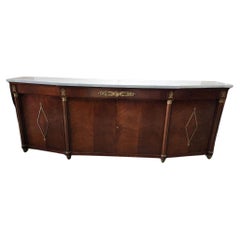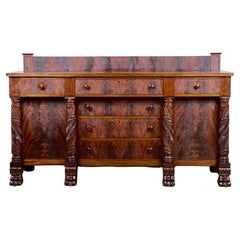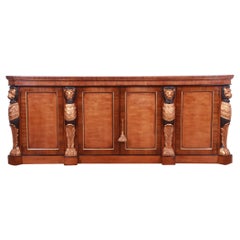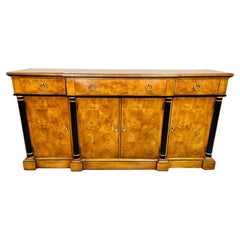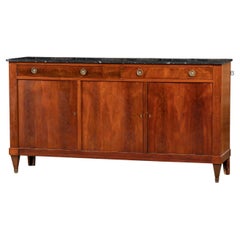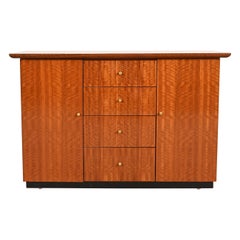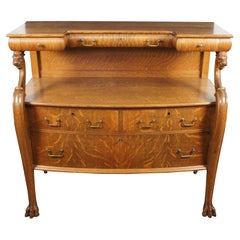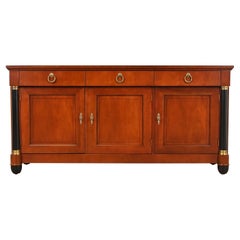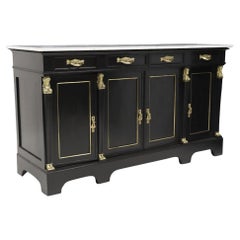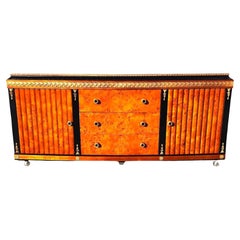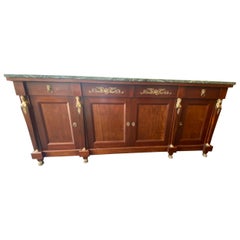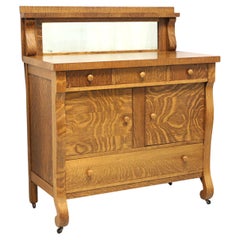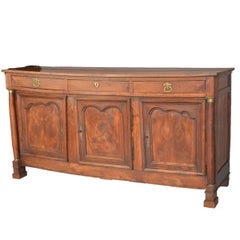Empire Style Sideboard
Vintage 1940s Empire Console Tables
Marble, Bronze
Antique Early 1900s American American Empire Sideboards
Mahogany
Late 20th Century American Empire Sideboards
Birch, Walnut, Giltwood
Vintage 1960s Italian Empire Revival Credenzas
Bronze
Late 20th Century American Neoclassical Credenzas
Brass
Early 20th Century French Empire Sideboards
Wood, Mahogany
Late 20th Century American Modern Buffets
Brass
Early 20th Century American Empire Sideboards
Oak
Late 20th Century American Neoclassical Sideboards
Brass
20th Century French Empire Buffets
Marble, Brass
Vintage 1980s Empire Sideboards
Burl, Lacquer
20th Century French Empire Sideboards
Marble
Vintage 1950s French Hollywood Regency Sideboards
Granite, Bronze
Vintage 1980s American Empire Credenzas
Brass
Vintage 1980s American Empire Sideboards
Brass
Antique 1760s American Empire Cabinets
Brass
Recent Sales
Early 20th Century American Empire Sideboards
Metal
Antique 19th Century French Empire Sideboards
Walnut
Vintage 1950s Belgian Empire Sideboards
Marble, Bronze
Late 20th Century European Empire Credenzas
20th Century Empire Sideboards
Brass
Antique 19th Century French Empire Sideboards
Porcelain, Wood
Vintage 1970s Empire Sideboards
Marble, Bronze
20th Century American Sideboards
Wood
Mid-20th Century French Empire Sideboards
Bronze
Early 20th Century American Late Victorian Sideboards
Glass, Mirror, Oak
Antique 19th Century French Empire Sideboards
Marble
Early 20th Century French Sideboards
Marble
Early 2000s Empire Sideboards
Kingwood
Vintage 1940s French Hollywood Regency Sideboards
20th Century Sideboards
Marble, Ormolu
Early 20th Century French Empire Buffets
Bronze
Antique Late 19th Century French Empire Buffets
Bronze
Vintage 1960s American Neoclassical Sideboards
Brass
Late 20th Century American Neoclassical Sideboards
Brass
Vintage 1960s American Neoclassical Sideboards
Cherry
Late 20th Century American Louis XVI Sideboards
Brass
Late 20th Century American Neoclassical Credenzas
Brass
Antique Late 19th Century French Empire Buffets
Marble
Late 20th Century American Neoclassical Sideboards
Brass
20th Century French Empire Sideboards
Marble
Antique Late 19th Century French Empire Sideboards
Wood, Mahogany, Oak
Early 20th Century French Empire Sideboards
Marble, Brass
Early 20th Century French Empire Buffets
Mahogany
Antique Early 19th Century Swedish Empire Sideboards
Pine
Late 20th Century French Empire Revival Sideboards
Brass
Early 20th Century American Empire Buffets
Cherry
Mid-20th Century Unknown Empire Sideboards
Cherry
Early 20th Century American Empire Sideboards
Cherry
Antique 1880s French Sideboards
Early 20th Century French Empire Sideboards
Marble, Brass
1990s American Neoclassical Credenzas
Mahogany
Antique Early 1900s French Napoleon III Sideboards
Marble
Vintage 1970s American Empire Credenzas
Burl
Late 20th Century American Empire Credenzas
Brass
Vintage 1960s American Empire Sideboards
Brass
Antique 19th Century French Empire Sideboards
Marble, Brass
Antique Mid-19th Century French Empire Sideboards
Marble, Bronze
Antique Early 19th Century Swedish Folk Art Sideboards
Pine
Vintage 1940s Argentine Sideboards
Marble
Vintage 1980s American Neoclassical Sideboards
Brass
Antique 1880s American Empire Sideboards
Wood
Antique Early 19th Century French French Provincial Buffets
Walnut
Late 20th Century American Neoclassical Credenzas
Brass
Late 20th Century American Neoclassical Sideboards
Brass
Late 20th Century American Regency Credenzas
Brass
Early 20th Century French Empire Buffets
Mahogany
Early 20th Century French Empire Buffets
Mahogany
Antique Early 19th Century American American Empire Sideboards
Bronze
Mid-20th Century American Empire Credenzas
Rosewood
Early 20th Century American American Empire Sideboards
Carrara Marble, Metal
Vintage 1920s French Empire Revival Buffets
Marble, Bronze, Gold Leaf
20th Century American Empire Console Tables
Brass
People Also Browsed
21st Century and Contemporary Books
Foil
Vintage 1950s American Mid-Century Modern Table Clocks and Desk Clocks
Metal, Chrome
21st Century and Contemporary American American Classical Beds and Bed F...
Wood
Mid-20th Century American Georgian Cabinets
Brass
21st Century and Contemporary Contemporary Color Photography
Plexiglass, Archival Paper, Photographic Paper, Photographic Film
20th Century Chinese Ceramics
Porcelain
21st Century and Contemporary Italian Modern Coffee and Cocktail Tables
Blown Glass
Mid-20th Century French Art Deco Figurative Sculptures
Marble, Spelter
21st Century and Contemporary Contemporary Landscape Paintings
Canvas, Ink, Acrylic
21st Century and Contemporary French Modern Benches
Steel
Antique Mid-19th Century English High Victorian Taxidermy
Other
Antique 15th Century and Earlier Malagasy Other Natural Specimens
Stone
Antique 1890s German Gothic Models and Miniatures
Iron
2010s American Ottomans and Poufs
Velvet
Vintage 1960s Italian Rococo Console Tables
Marble
2010s American Organic Modern Console Tables
Aluminum
Empire Style Sideboard For Sale on 1stDibs
How Much is a Empire Style Sideboard?
Finding the Right Case Pieces And Storage Cabinets for You
Of all the vintage storage cabinets and antique case pieces that have become popular in modern interiors over the years, dressers, credenzas and cabinets have long been home staples, perfect for routine storage or protection of personal items.
In the mid-19th century, cabinetmakers would mimic styles originating in the Louis XIV, Louis XV and Louis XVI eras for their dressers, bookshelves and other structures, and, later, simpler, streamlined wood designs allowed these “case pieces” or “case goods” — any furnishing that is unupholstered and has some semblance of a storage component — to blend into the background of any interior.
Mid-century modern furniture enthusiasts will cite the tall modular wall units crafted in teak and other sought-after woods of the era by the likes of George Nelson, Poul Cadovius and Finn Juhl. For these highly customizable furnishings, designers of the day delivered an alternative to big, heavy bookcases by considering the use of space — and, in particular, walls — in new and innovative ways. Mid-century modern credenzas, which, long and low, evolved from tables that were built as early as the 14th century in Italy, typically have no legs or very short legs and have grown in popularity as an alluring storage option over time.
Although the name immediately invokes images of clothing, dressers were initially created in Europe for a much different purpose. This furnishing was initially a flat-surfaced, low-profile side table equipped with a few drawers — a common fixture used to dress and prepare meats in English kitchens throughout the Tudor period. The drawers served as perfect utensil storage. It wasn’t until the design made its way to North America that it became enlarged and equipped with enough space to hold clothing and cosmetics. The very history of case pieces is a testament to their versatility and well-earned place in any room.
In the spirit of positioning your case goods center stage, decluttering can now be design-minded.
A contemporary case piece with open shelving and painted wood details can prove functional as a storage unit as easily as it can a room divider. Alternatively, apothecary cabinets are charming case goods similar in size to early dressers or commodes but with uniquely sized shelving and (often numerous) drawers.
Whether you’re seeking a playful sideboard that features colored glass and metal details, an antique Italian hand-carved storage cabinet or a glass-door vitrine to store and show off your collectibles, there are options for you on 1stDibs.
- 1stDibs ExpertApril 5, 2022The Classical world is primarily what influenced French Empire furniture. Greek and Roman motifs appear on many pieces. In addition, the opulence of Egyptian furniture inspired furniture makers active during the period. On 1stDibs, shop a range of French Empire furniture.
- 1stDibs ExpertOctober 7, 2024The difference between the Biedermeier and Empire styles lies largely in the characteristics most commonly associated with them. Although these two furniture styles both emerged around 1815 and persisted into the 1840s, pieces associated with them have differing features. Developed in France, the Empire style emphasized ornamentation and grandeur, with furniture makers often drawing inspiration from ancient Roman forms. Dark woods were the most commonly used materials of the style. In Germany and other parts of Central Europe, artisans working in the Biedermeier style favored simplicity. They also tended to source woods locally and chose light finishes for their pieces. Explore a selection of Biedermeier and Empire furniture on 1stDibs.
Read More
The Ultimate Guide to Types of Tables for the Home
Whether you’re just moving in or ready to give your home a makeover, our guide will give you pointers on tables that are fitting for every room, nook and hallway.
What Exactly Is a Secretary Desk, and What Is It Used For?
The furniture equivalent of a Swiss Army knife, it's the multifunctional piece you didn't know you needed.
This Shelving System with Oxidized Brass Tubes Is Retro and Futuristic at Once
Italian studio DimoreMilano mustered great ingenuity when crafting these sculptural shelves, which are built without any screws.
28 Cheerful Home Bars, Where Everybody (Literally) Knows Your Name
Simple or sophisticated, equipped with console, cart or custom cabinetry, these stylish bar areas deserve a toast.
Ask an Interior Designer: Work-from-Home Edition
Leaping into a design project, whether it's refreshing the bedroom or redoing the whole house, can be overwhelming. Luckily, we know more than a few interior designers. You asked questions on Instagram, and now they're answering.
Collected and Eclectic, ‘Wunderkammern’ Are Back in a Big Way
Introduced nearly 500 years ago, curiosity cabinets are finding new fans among today's collectors and designers.
Meet the Incredible Woman Transforming Fallen Trees into Sleek Furniture
In the hands of New York Heartwoods cofounder Megan Offner, unwanted local trees become works of design art.
These New York Architects Love a Complicated Project
From Brooklyn townhouses to Maine campgrounds, Trattie Davies and Jonathan Toews relish a challenge, like transforming a former warehouse space into the new 1stdibs Gallery.
